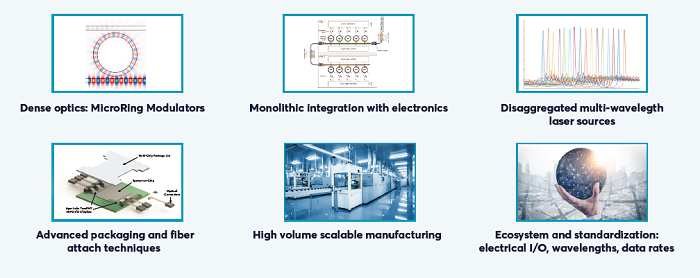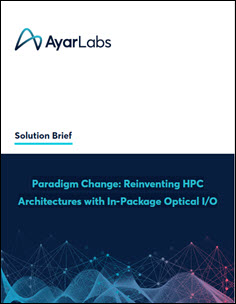This white paper from Ayar Labs, “Paradigm Change: Reinventing HPC Architectures with In-Package Optical I/O,” discusses an important innovation: reinventing HPC architectures with in-package optical I/O. The introduction of in-package optical I/O technology helps HPC centers accelerate the slope of compute progress needed to tackle ever-growing scientific problem sizes and HPC/AI convergence. Ayar Labs expects to not only see its technology extend the traditional type of architecture to put the HPC industry back on track, but also result in an inflection point that fundamentally changes the slope of the compute performance efficiency curve. The key will be enabling converged HPC/AI centers to build systems with disaggregated CPUs, GPUs, FPGAs and custom ASICs interconnected on equal footing.
Just as Moore’s Law has slowed down, the infusion of AI into HPC has steepened the slope of the compute performance efficiency curve at the system level. The DOE’s AI for Science report states that, “if the largest model training costs continue their current growth rate of 10x/year, economic and environmental consequences will ultimately be the practical limits.” This can only be sustained with new architectures and distributed compute. Christopher Berner, Head of Compute at OpenAI has underscored the need for breakthrough technical innovations, stating “OpenAI must be on the cutting edge of AI capabilities and low latency, high bandwidth optical interconnect is a central piece of our compute strategy to achieve our mission of delivering artificial intelligence technology that benefits all of humanity.”

Six critical factors that are required to enable broad adoption of optical I/O
This white paper includes the following important sections:
- Introduction
- Growing problem sizes, persistent bottlenecks
- Finding more efficient ways forward
- Enabling next-generation optical connectivity using a practical approach
- Manufacturing approach matters
- Conclusion
“Even with the first exascale systems coming soon, HPC centers are searching for the technologies that will provide post-exascale levels of processing, bandwidth, and memory. Given space constraints and the limitations of current materials, chips are running up against the laws of physics, making gains from clever engineering harder to come by. Without significant breakthroughs, it will be increasingly difficult to improve the computing power available per dollar.”
At last, optical I/O has emerged as the best solution to drive the next phase of Moore’s Law-like advances in post-exascale systems performance. In part, this is because there have not been game-changing breakthroughs in the materials used in traditional interconnects. The result: I/O progress has remained relatively flat over the years as the byte per FLOP (B/F) ratio has steadily decreased, limiting the ability of CPUs and HPC systems, (bogged down by insufficient bandwidth) to run at their full potential.
Download the new white paper courtesy of Ayar Labs, “Paradigm Change: Reinventing HPC Architectures with In-Package Optical I/O” to understand how in-package optical I/O technology helps HPC centers accelerate the slope of compute progress needed to tackle ever-growing scientific problem sizes and HPC/AI convergence.




